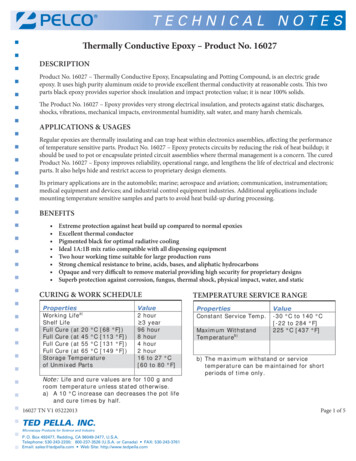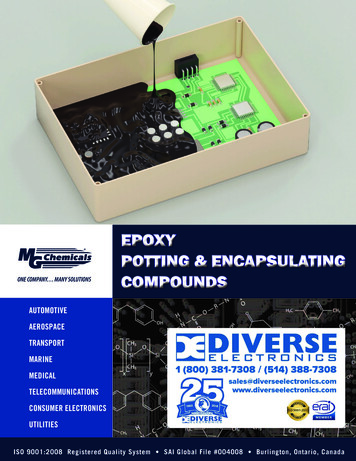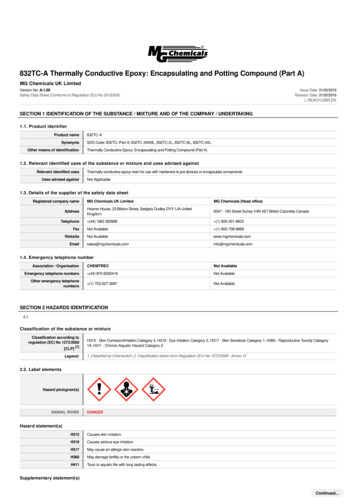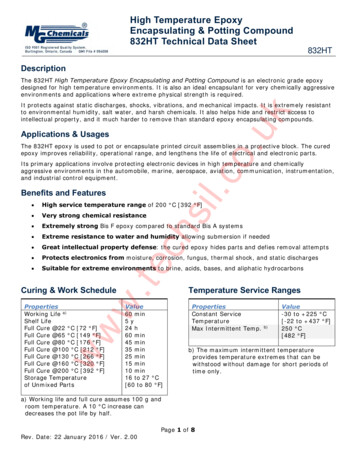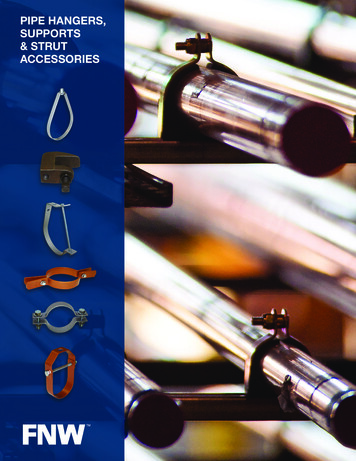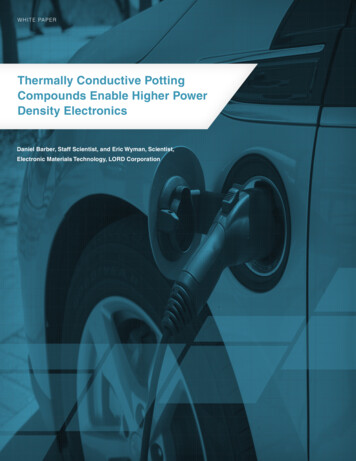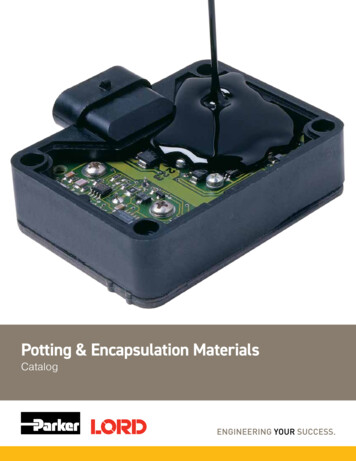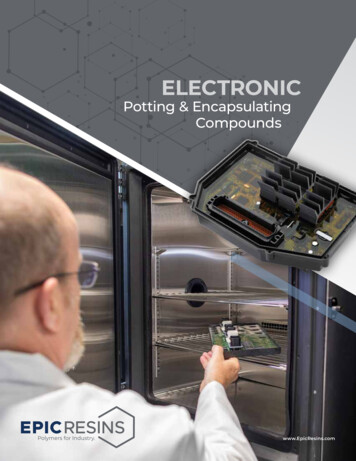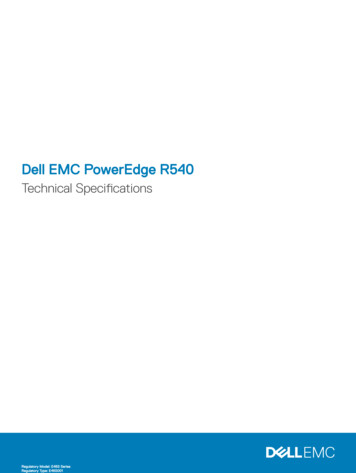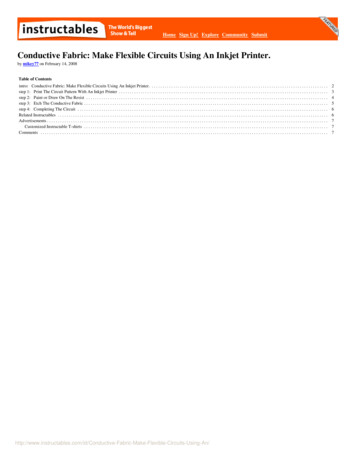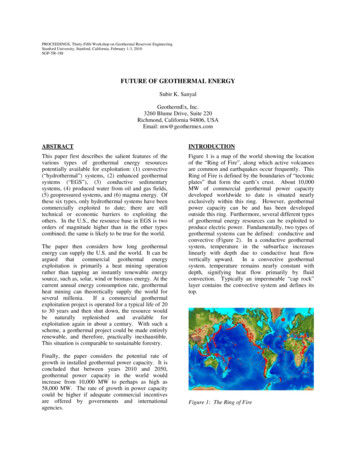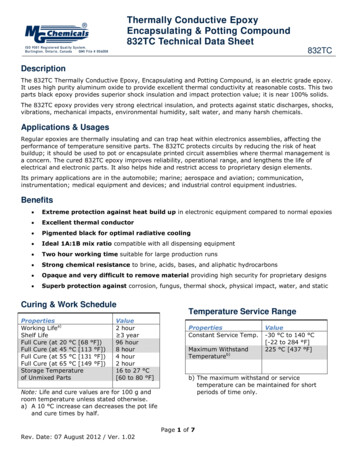
Transcription
Thermally Conductive EpoxyEncapsulating & Potting Compound832TC Technical Data Sheet832TCDescriptionThe 832TC Thermally Conductive Epoxy, Encapsulating and Potting Compound, is an electric grade epoxy.It uses high purity aluminum oxide to provide excellent thermal conductivity at reasonable costs. This twoparts black epoxy provides superior shock insulation and impact protection value; it is near 100% solids.The 832TC epoxy provides very strong electrical insulation, and protects against static discharges, shocks,vibrations, mechanical impacts, environmental humidity, salt water, and many harsh chemicals.Applications & UsagesRegular epoxies are thermally insulating and can trap heat within electronics assemblies, affecting theperformance of temperature sensitive parts. The 832TC protects circuits by reducing the risk of heatbuildup; it should be used to pot or encapsulate printed circuit assemblies where thermal management isa concern. The cured 832TC epoxy improves reliability, operational range, and lengthens the life ofelectrical and electronic parts. It also helps hide and restrict access to proprietary design elements.Its primary applications are in the automobile; marine; aerospace and aviation; communication,instrumentation; medical equipment and devices; and industrial control equipment industries.Benefits Extreme protection against heat build up in electronic equipment compared to normal epoxies Excellent thermal conductor Pigmented black for optimal radiative cooling Ideal 1A:1B mix ratio compatible with all dispensing equipment Two hour working time suitable for large production runs Strong chemical resistance to brine, acids, bases, and aliphatic hydrocarbons Opaque and very difficult to remove material providing high security for proprietary designs Superb protection against corrosion, fungus, thermal shock, physical impact, water, and staticCuring & Work SchedulePropertiesWorking Lifea)Shelf LifeFull Cure (at 20 C [68 F])Full Cure (at 45 C [113 F])Full Cure (at 55 C [131 F])Full Cure (at 65 C [149 F])Storage Temperatureof Unmixed PartsValue2 hour 3 year96 hour8 hour4 hour2 hour16 to 27 C[60 to 80 F]Note: Life and cure values are for 100 g androom temperature unless stated otherwise.a) A 10 C increase can decreases the pot lifeand cure times by half.Temperature Service RangePropertiesConstant Service Temp.Maximum WithstandTemperatureb)b) The maximum withstand or servicetemperature can be maintained for shortperiods of time only.Page 1 of 7Rev. Date: 07 August 2012 / Ver. 1.02Value-30 C to 140 C[-22 to 284 F]225 C [437 F]
Thermally Conductive EpoxyEncapsulating & Potting Compound832TC Technical Data Sheet832TCPrincipal ComponentsNamePart A: Bis-F Epoxide ResinAluminum OxidesPart B: Curing PolyamideTriethylene tetramineAluminum OxidesCAS -1Properties of Cured 832TCPhysical PropertiesColorDensity (at 26 C)HardnessTensile StrengthElongationLap Shear StrengthIzod Impactb)Compression StrengthFlexural StrengthMethodVisualElectric PropertiesBreakdown Voltage @ 3.118 mmDielectric StrengthBreakdown Voltage @3.175 mm [1/8”]Dielectric StrengthVolume ResistivitySurface Resistanced)Comparative Tracking IndexDielectric Dissipation & ConstantDissipation & Constant@1 MHzMethodASTM D 149"Reference fitc)"ASTM D 257"ASTM D 3628Thermal PropertiesThermal ConductivityThermal DiffusivityVolumetric Specific HeatCTE (prior Tg) eCTE (after Tg) eOverall CTE (-40 to 250 C) eGlass Transition Temperature (Tg)Heat Deflection TemperatureMethod(Shore D durometer)ASTM D 638"ASTM D 1002ASTM D 256ASTM D 695ASTM D 790ASTM D 150-98ASTMASTMASTMASTMASTME 831E 831E 831D 3418D 648Valuea)Black1.83 g/cm382D18.85 N/mm21.87%22.2 N/mm21.7 kJ/m228.19 N/mm2113.76 N/mm2[2,734 lb/in2][3224 lb/in2][0.80 ft·lb/in][4,088 lb/in2][5,352 lb/in2]Value45.7 kV14.7 kV/mm [373 V/mil]46.2 kV14.6 kV/mm [370 V/mil]2.58 x1015 Ω cm3.16 x1016 Ω/sqNot establisheddissipation, Dconstant, k’0.0114.41Value0.682 W/(m K)0.38 mm2/s1.9 MJ/(m3 K)66.2 ppm/ C166.9 ppm/ C148.3 ppm/ C25.4 C [77.7 F]35.4 C [95.6 F]a) N/mm2 mPa; lb/in2 psib) Cantilever beam impactc) To allow comparison between products, the Tautschter equation was fitted to 5 experimental dielectricstrengths and extrapolated to a standard reference thickness of 1/8” (3.175 mm).d) The surface (sheet) resistivity unit is commonly referred to as “Ohm per square”e) Coefficient of Thermal Expansion (CTE) units are in ppm/ C in/in/ C 10-6 unit/unit/ C 10-6Page 2 of 7Rev. Date: 07 August 2012 / Ver. 1.02
Thermally Conductive EpoxyEncapsulating & Potting Compound832TC Technical Data Sheet832TCProperties of Uncured 832TCPhysical PropertyColorViscosity at 20 C [73 F]aDensityMix Ratio by Volume (A:B)Mix Ratio by Weight (A:B)Solids Content (w/w)Physical PropertyColorViscosity at 24 C [73 F] aDensityFlash PointOdorMixture (2A:1B)Black38,000 cP to 40,000 cP [38 Pa·s to 40 Pa·s]1.616 g/mL1.0:1.01.2:1.0 100%Part ABlack17,900 cP [17.9 Pa·s]1.802 g/mL190 C [374 F]Slight OdorPart BBlack23,100 cP [23.1 Pa·s]1.504 g/mL93 C [199 F]Slight Odora) Brookfield viscometer at 20 RPM for Part A and 10 RPM Part B with spindle LV4CompatibilityAdhesion—As seen in the substrate adhesion table, the 832TC epoxy adheres to most materials found onprinted circuit assemblies; however, it is not compatible with contaminants like water, oil, and greasy fluxresidues that may affect adhesion. If contamination is present, clean the printed circuit assembly withelectronic cleaner such as MG Chemicals 4050 Safety Wash, 406B Superwash, or 824 Isopropyl Alcohol.Substrate Adhesion in Decreasing OrderPhysical ) Does not bond to polypropylenePage 3 of 7Rev. Date: 07 August 2012 / Ver. 1.02
Thermally Conductive EpoxyEncapsulating & Potting Compound832TC Technical Data Sheet832TCChemical Resistance—The chemical solvent resistance table presents the percent weight change overthe indicated period. The results show low water absorption and a high chemical resistance to water andmost ionic species. Softening and swelling occurs for aggressive organic solvents.Chemical Solvent ResistancePhysical PropertiesWaterIsopropyl AlcoholMineral SpiritsIso HexanesHydrochloric AcidEthyl LactateXyleneAcetoneWeight Change3 days 0 % 0% 0 % 0 %0.5 %1%2%3%StorageStore between 16 and 27 C [60 and 80 F] in dry area away from sunlight. Prolonged storage or storageat or near freezing temperatures can result in crystallization. If crystallization occurs, reconstitute thecomponent to its original state by temporarily warming it to 50 to 60 C [122 to 140 F]. To ensure fullhomogeneity, stir thoroughly the warm component, reincorporating all settled material. Re-securecontainer lid and let cool down before use.Page 4 of 7Rev. Date: 07 August 2012 / Ver. 1.02
Thermally Conductive EpoxyEncapsulating & Potting Compound832TC Technical Data Sheet832TCHealth, Safety, and Environmental AwarenessPlease see the 832TC Material Safety Data Sheet (MSDS) parts A and B for more details ontransportation, storage, handling and other security guidelines.Health and Safety: The 832TC parts can ignite if the liquid is heated.Wear safety glasses or goggles and disposable polyvinyl chloride, neoprene, or nitrile gloves whilehandling liquids. Part B in particular causes skin burns and may cause sensitization if exposed over a longperiod of time. The epoxy is black and will not wash off once cured: wear protective work clothing. Washhands thoroughly after use or if skin contact occurs. Do not ingest.Although the product has low volatility and moderate odor, use it in a well-ventilated area.The cured epoxy resin presents no known hazard.Part AHMIS RATINGNFPA 704 CODESHEALTH:2FLAMMABILITY:1PHYSICAL HAZARD:012PERSONAL PROTECTION:0Part BHMIS RATINGNFPA 704 CODESHEALTH:2FLAMMABILITY:1PHYSICAL HAZARD:012PERSONAL PROTECTION:Approximate HMIS and NFPA Risk Ratings Legend:0 (Low or none); 1 (Slight); 2 (Moderate); 3 (Serious); 4 (Severe)Page 5 of 7Rev. Date: 07 August 2012 / Ver. 1.020
Thermally Conductive EpoxyEncapsulating & Potting Compound832TC Technical Data Sheet832TCApplication InstructionsFollow the procedure below for best results. If you have little or no experience with the 832TC epoxy,please follow the long instructions instead. The short instructions provided here are not suitable for firsttime users.To prepare 1:1 (A:B) epoxy mixture1. Carefully scrape any settled material in the Part A container; and stir and fold material untilhomogenous.2. Carefully crape any settled material in the Part B container; and stir and fold material untilhomogenous.3. Measure one parts by volume of the pre-stirred A, and pour in the mixing container.4. Measure one part by volume of the pre-stirred B, and slowly pour in the mixing container whilestirring.5. Put in a vacuum chamber, bring to 25 Hg/in pressure, and wait for 2 minutes to de-air.—OR—Let sit for 30 minutes to de-air.6. If bubbles are present at top, use the mixing paddle to gently break them.7. Pour mixture into the mold or container containing the components to be encapsulated.ATTENTION ! Mixing 500 g [0.4 L] of Part B at a time into A decreases working life and promotes flashcure. Use of epoxy mixing machines with static stirrer recommended for large volumes. Limit size of handmixed batches.TIP: Due to the high viscosity and abrasiveness of the aluminum oxide filler, you may preheat parts A andpart B with temperature jacket to increase the flow and improve air release. This will help reduce the wearon the mixing equipment, but it will shorten the working life.To room temperature cure the 832TC epoxyLet stand for 24 hours.To heat cure the 832TC epoxyPut in oven at 45 C [113 F] for 8 hour.–OR–Put in oven at 55 C [131 F] for 4 hour.–OR–Put in oven at 65 C [149 F] for 2 hour.ATTENTION !Due to exothermic reaction, heat cure temperatures should be at least 25% below the maximumtemperature tolerated by the most fragile PCB component. For larger potting blocks, reduce heat curetemperature by greater margins.Page 6 of 7Rev. Date: 07 August 2012 / Ver. 1.02
Thermally Conductive EpoxyEncapsulating & Potting Compound832TC Technical Data Sheet832TCPackaging and Supporting ProductsProduct AvailabilityCat. iquidLiquidLiquidNet Volume0.455 L16 oz2.0 L 0.5 gal7.6 L 2.1 gal40.5 L10 galNet Weight0.75 kg1.72.57 kg5.712.6 kg27.767.0 kg148lblblblbShipping Weight1.1 kg2.5 lb3.6 kg8 lb14 kg31 lb70 kg154 lbSupporting Products 8328 Epoxy and Adhesive Cleaner 8329 Epoxy Mold Release (for temperature cures 85 C)Technical SupportContact us regarding any questions, improvement suggestions, or problems with this product. Applicationnotes, instructions, and FAQs are located at www.mgchemicals.com.Email: support@mgchemicals.comPhone: 1-800-340-0772 Ext. 130 (Canada, Mexico & USA)1-905-331-1396 Ext. 130 (International)Fax: 1-905-331-2862 or 1-800-340-0773Mailing address:Manufacturing & Support1210 Corporate DriveBurlington, Ontario, CanadaL7L 5R6Head Office9347–193rd StreetSurrey, British Columbia, CanadaV4N 4E7WarrantyM.G. Chemicals Ltd. warranties this product for 12 months from the date of purchase by the end user.M.G. Chemicals Ltd. makes no claims as to shelf life of this product for the warranty. The liability of M.G.Chemicals Ltd. whether based on its warranty, contracts, or otherwise shall in no case include incidental orconsequential damage.DisclaimerThis information is believed to be accurate. It is intended for professional end users having the skills toevaluate and use the data properly. M.G. Chemicals Ltd. does not guarantee the accuracy of the data andassumes no liability in connection with damages incurred while using it.Page 7 of 7Rev. Date: 07 August 2012 / Ver. 1.02
Encapsulating & Potting Compound 832TC Technical Data Sheet Chemical Resistance—The chemical solvent resistance table presents the percent weight change over the indicated period. The results show low water absorption and a high chemical resistance to water and most ionic species. Softening and swelling occurs for aggressive organic solvents.
